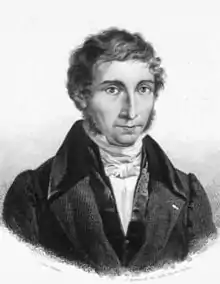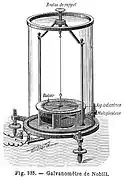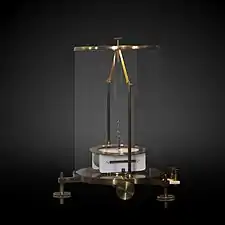Leopoldo Nobili | |
|---|---|
 | |
| Born | 5 July 1784 |
| Died | 22 August 1835 (aged 51) |
Leopoldo Nobili, born on 5 July 1784[1] in Trassilico (Toscana) and died on 22 August 1835[1] in Florence, was an Italian physicist who invented a number of instruments critical to investigating thermodynamics and electrochemistry.
Born Trassilico, Garfagnana, after attending the Military Academy of Modena he became an artillery officer. He was awarded the Légion d'honneur for his service in Napoleon's invasion of Russia.
In 1825 he developed the astatic galvanometer.[2][3]
 Schematics of Nobili's Galvanometer
Schematics of Nobili's Galvanometer Galvanometer on display at MHS Geneva
Galvanometer on display at MHS Geneva
He worked with Macedonio Melloni on the thermomultiplier, a combination of thermopile and galvanometer,[4][5] before being appointed professor of physics[6] at the Reale Museo di Fisica e Storia Naturale (Royal Museum of Physics and Natural History) in Florence where he worked with Vincenzo Antinori on electromagnetic induction.
He was also credited with the discovery of 'Nobili's Rings'. "When a dilute solution of copper acetate is placed on a bright silverplate and a strip of zinc is touched to the silver beneath the copper, a series of rings of copper are formed by electrolysis around the zinc."[7]
References
- 1 2 Schettino, E. "NOBILI, Leopoldo". Dizionario Biografico degli Italiani. Enciclopedia Italiana. Retrieved 31 August 2015.
- ↑ Nobili, Leopoldo (1825). "Sur un nouveau galvanomètre présenté à l'Académie des Sciences" [On a new galvanometer presented at the Academy of Sciences]. Bibliothèque Universelle (in French). 29: 119–125.
- ↑ Greenslade, Thomas. "Instruments for Natural Philosophy — Astatic Galvanometer". Kenyon College. Retrieved 2010-12-19.
- ↑ See:
- Nobili, Leopoldo (1830). "Description d'un thermo-multiplicateur ou thermoscope électrique" [Description of a thermo-multiplier or electric thermoscope]. Bibliothèque Universelle (in French). 44: 225–234.
- Nobili; Melloni (1831). "Recherches sur plusieurs phénomènes calorifiques entreprises au moyen du thermo-multiplicateur" [Investigations of several heat phenomena undertaken via a thermo-multiplier]. Annales de Chimie et de Physique. 2nd series (in French). 48: 198–218.
- ↑ Barr, E. S. (1962). The infrared pioneers—II. Macedonio Melloni. Infrared Physics, 2(2), 67-74.
- ↑ Goethe's Theory of Colours, Part II: Physical Colours, Eastlake's Note R
- ↑ Thomas O'Conor Sloane, The Standard Electrical Dictionary: A Popular Dictionary of Words and Terms, London 1898, p. 392
Works
- Introduzione alla meccanica della materia (in Italian). Milano: Paolo Emilio Giusti. 1819.
- Questioni sul magnetismo (in Italian). Milano: eredi Soliani. 1824.